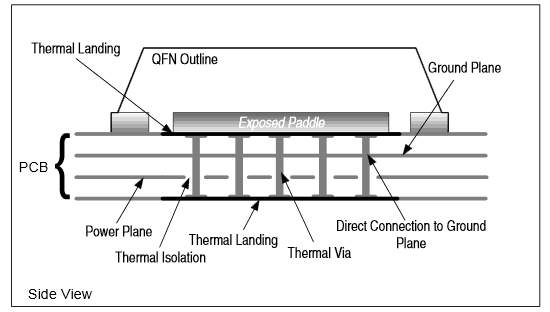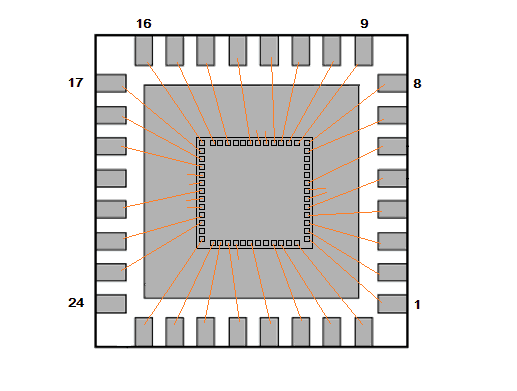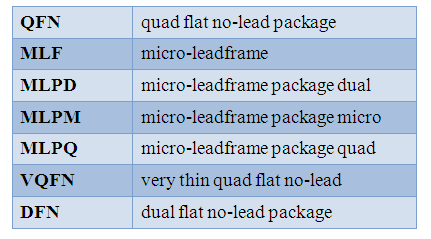The Ultimate Guide to QFN Package
QFN Package Overview
The QFN (Quad Flat No-lead) package is probably the most popular semiconductor package today because of four reasons: low cost, small form factor and good electrical and thermal performance.
Like any other semiconductor package, a QFN package functionality is to connect (both physically and electrically) silicon dies (the ASIC) to a printed circuit board (PCB) using surface-mount technology. QFN is a lead frame-based package which is also called CSP (Chip Scale Package) with the ability to view and contact leads after assembly.
QFN packages typically use a copper lead frame for the die assembly and PCB interconnection.
The QFN can have a single or a multiple rows of pins. The single row structure is formed either by a punch singulation or a saw singulation process, both of these methods divides a large array of packages (for example an 18” x 24” sheet) into individual packages. The multi-row QFN uses an etching process to realise the wanted number of rows and pins; these are then also singulated, typically by saw.
QFNs have an exposed thermal pad on the bottom of the package that can be soldered directly to the system PCB for optimal thermal transfer of heat from the die.
The benefits that come from choosing the QFN packages include a decreasing lead inductance due to optimally short bond wires, light weight, thin profile and small sized “near chip scale” footprint. Moreover, thanks to the exposed copper die pad, the QFN is perfect for many new applications that need better performance in size, weight and their thermal and electrical properties. Downsides of adopting QFN packages include a possible floatation of the 3×3 mm DFN packages on the on the pool of molten solder under the thermal pad during assembly; oxidation problems of the exposed chip contact pads; missing clearance of a soldering pencil to reflow pads under the chip if touch up is desired. These issues can be mitigated by better control of the re-flow process and using QFNs which are plated (tin common) to lessen oxidisation issues
Wire Bond QFN vs. Flip Chip QFN
Although a wire bonding is the most common method for die to package connectivity, some packaging houses are offering a flip chip QFN version as well that has better electrical performance.
Flip Chip QFN offers size reduction compared to conventional QFN package as well as better electrical performance due to the direct connectivity to the lead frame.
However, Flip Chip QFN does require a bumping process in addition to the assembly steps, therefore in most cases Flip Chip QFN cost will be on the high side.
Punched vs Sawn QFN
Higher volume production tends to support sawn type QFN; punch type is often seen with lower volume products; they both have very similar electrical and thermal properties.
QFN LeadFrame Overview
Every QFN package consists of a LeadFrame, which is a copper frame surrounding the die and consists of all the package pads (fingers) and the exposed pad. A leadframe is typically made as a large flat sheet of copper with 0.3-0.4 mm thickness with Matt Tin coating. The sheet is going through a Photochemical etching process to remove the unnecessary area. Afterwards the edged sheets are diced into strips. The inner leads are used for wire bonding the outer leads are used as the QFN package leads.
In the assembly process the leadframe strips are going through a stamping process. When the stamping process is completed, the assembly process can start. A wire bonder will then connect the die pad to the leadframe pad and of course add optional downbonds from the die to the exposed pad for grounding.
Unused leadFrame shelf life time at packaging assembly house is approximately 1 year; this means that after one year, the packaging house will ask you to pay for making new LeadFrames for your QFN package.
Read about “Lead Frame Overview and Custom Lead Frame Benefits“.
QFN Thermal Characteristics
The QFN package exposed pad (or paddle) offers a low thermal resistance path for heat transfer to the PCB and therefore it’s recommended to solder the exposed pad to a large conductive surface such as GND plane. This path carries approximately 70% of the heat away from the Package. With the presence of metal plane the heat flow via the exposed pad can increase to 90%.

QFN packages allows for good electrical and physical connection in between the PCB and the IC, thanks to the metal vias in the thermal pads that facilitate the heat transfer. There are different types of QFN. Two of the most common are: air-cavity QFNs (made of three parts such as: copper leadframe, ceramic or plastic-molded body, and either a ceramic or plastic lid) and the plastic molded QFN (characterised by being fully molded with no air in the package).
QFN Electrical Characteristics
Thermal pad, or exposed pad, is an efficient method of drawing heat from the die to the PCB. QFN is a thermal efficient package and the exposed pad is a very cost-effective solution. QFNs can handle up to 2W-3W without forced air cooling.
Different manufacturers call these packages with different names such as MLF (micro lead frames), FL (flat no lead), they are available with pads on only two sides as well as the more typical four sides.
QFN Bonding Diagram
When the QFN package design needs to start the assembly house will ask you for a few documents. One of them is the bonding diagram that shows the connectivity between the die and the package pads. The bond diagram shows an example for a 16 pin QFN. The short wire bonds are indication to down bonds e.g. interconnect to the exposed pad.

QFN Marking Specification
QFN package is relatively small and therefore does now allow much space for legible marking. A 5mm x 5mm QFN can have up to 5 or 6 characters in one line; 3 or 4 lines are possible.
Wire Bonding
Gold was the default material for many years. It is still available but is being replaced by copper. Pros with copper are lower cost and better conductivity; cons are that a good intermetallic bond at the pad is more of a challenge and that the force required to bond (the force applied to the pad) is greater than for gold. Many foundries supply IO pad cells designed to support copper bonding as a thicker pad is usually needed.
Die Attach
This is the epoxy material that fixes the die to the leadframe pad. Two main types are used, conductive and non-conductive, depending on the systems electrical requirements; electrically conductive materials (i.e. silver-loaded epoxy) tend also to have better thermal conductive properties.
Other Names for QFN
Thanks to the benefits of QFN package and the successful market penetration, most of the assembly houses provide QFN packaging services; however, they are using different names.

Capacités
Capacité PCB rigide
Capacité PCB flexible
Capacité d'assemblage PCB
Équipement PCB
Équipement d'assemblage PCB
Méthodes de paiement
Prix spéciaux
Transporteurs
Support pour amateurs
Certificat
Assistance clientèle
Suivez-nous
Tel: 1-905-339-2881
Email: [email protected] , [email protected]
Copyright Gold Phoenix PCB Co., Ltd. 2011 - 2023
Tel: 1-905-339-2881 Email: [email protected] , [email protected]
Système de contrôle qualité | Service produit
| Liens
Copyright Gold Phoenix PCB Co., Ltd. 2011 - 2023


